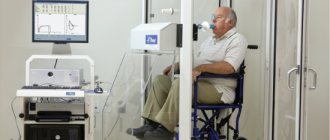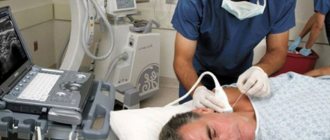- Description
- Let's figure it out
- My opinion
- Conclusion
Hello friends. Today we will try to find out the purpose of the Alt Gr button on the keyboard. Surprisingly, I have never heard of such a button, and the most interesting thing is that I just looked - it turns out that it is also on my keyboard, which I have been using for many years. This gives me some ideas.
IMPORTANT:
It turns out that one special character has been officially created for Russia, which can be entered using the AltGr key!
How to write correctly
- Briefly. The maximum recommended length is 125 characters. One of the most popular screen readers, JAWS, does not like long lines. He can read very long lines as three pictures, although it was just one long line.
- Clearly. We need to answer the question, what exactly is shown in the picture? What function does it perform?
- Unique. Don't repeat text that's already on the page.
- Don't start with the words "picture" or "image."
- Take cues from the surrounding content.
- Follow the rules of the language in which the description is written: punctuation, spelling.
Examples of using
Picture
This can be described if the article contains text that talks about photography.
If there is no text, for example, we have an image gallery, then we need to describe the picture in more detail:
Link
There is no need to start the text with “link”; the tag itself plays the role of clarification.
Diagram
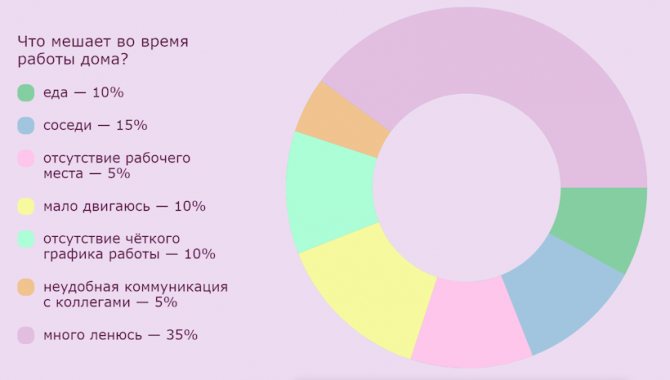
If there is no text with statistics, then you will have to put all the statistics in alt:
Picture with text

Just move the text to alt:
Figure and figcaption
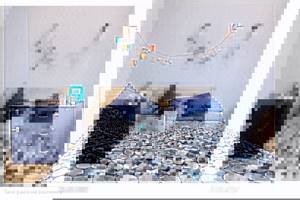
We still write a normal alt, since the figcaption usually has a small description:
Tanya went to warm up
My opinion
Personally, my keyboard also has Alt Gr, located on the right. But my keyboard is generally German, there are no Russian letters, only German ones, maybe that’s why there is an Alt Gr button so that you can enter special characters characteristic of Germany.
Alt Gr also works for me just like left Alt. It's just that it's right - they're not the same, it's literally left and right, so some functions only work in combination with left, and others only work in combination with right. Although personally I almost never use the right Alt, the left one is convenient. But Alt Gr works, yes, but just like regular Alt.
No matter how many times I tried to press combinations, I couldn’t enter any symbols.
Also, just for fun, I looked at several keyboards - I didn’t find the Alt Gr button, only the regular Alt:
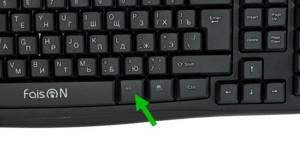
Maybe it is present only on foreign, that is, for the European market, so to speak.
ATTENTION! It turns out that Alt Gr works for me, but only one character - I can enter the ruble icon if I press Alt Gr + 8:

Only Windows 10 should be on the oldest one.
Apart from this character, nothing else could be entered. You can read about other symbols here (only there in English):
https://en.wikipedia.org/wiki/AltGr_key
As already mentioned, the trick is that each country has its own signs. Here are some for Belgium:

But for Poland:
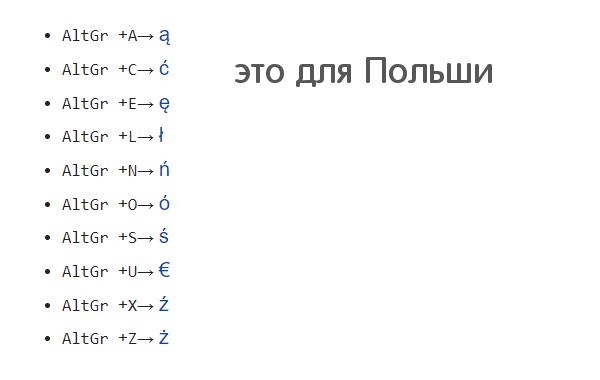
That is, the AltGr button was created for convenience, to make it easier to enter special characters, which each country has its own.
What happens if you forget about alt text
There are two main problems: users will not see anything, and screen readers may read it incorrectly or not. For example, NVDA will say nothing, JAWS will say “Graphic without description,” and VoiceOver will say the file name.
But sometimes there are pictures that do not have an alt added. For example, this is a search for “red cat”, and thousands of red cats are shown in the search results. There is no point in specifying alt.
Most often, in such a situation, alt is removed altogether:
But in this case, some screen readers will start reading src, which is even worse. Therefore, it is better to leave alt empty. Of two evils, choose the lesser.
Complete list of keyboard shortcuts
Often reading articles on the Internet or instructions for installing a program, you may come across key combinations
(Ctrl-C, Ctrl-V, Win-R, Alt-Tab, Alt-F4, etc.). And if you still don’t know what they mean, then you can read them in our article.
This article presents a complete list of keyboard shortcuts used not only in the Windows operating system.
- Basic keyboard shortcuts
- General purpose hotkeys
- Keyboard combinations for working with text
- Keyboard shortcuts for working with files
- Keyboard shortcuts for working in Explorer
- Keyboard shortcuts for working with windows
- Keyboard shortcuts for working with dialog boxes
- Keyboard shortcuts for working in browsers (Internet Explorer, Google Chrome, Mozilla)
- Special abilities
Basic keyboard shortcuts
Alt+Tab
– Switch between windows
Win+Tab
– Switch between windows in Flip 3D mode
Win+Up
– Maximize window
Win+Down
– Restore/Minimize window
Win+Left
– Snap window to left edge of screen
Win+Right
– Snap window to right edge of screen
Win +Shift+Left
– Switch to the left monitor
Win+Shift+Right
– Switch to the right monitor
Win+Home
– Minimize / Restore all inactive windows
Win+Break (or Pause)
– Launch the System item from the Control Panel (Properties item when right-clicking mouse on Computer in the Start menu)
Win+Space
– Show the desktop
Win+B
– Go to the notification area (tray)
Win+D
– windows or restore all windows
Win+E
– Launch Explorer
Win+F
– Launch built-in dialog Windows search
Win+Ctrl+F
– Launch Search on a computer from a domain
Win+F1
– Launch the built-in Windows dialog: Help and Support
Win+G
– Display gadgets on top of all windows
Win+L
– Lock the workstation (current user session)
Win+M
– Minimize all windows
Win+P
– Display additional display options (extend the desktop to 2 monitors, etc.)
Win+R
– Launch the Run dialog box
Win+T
– Select the first item in the taskbar (Pressing again switches to the next item ,
Win+Shift+T
– scrolls in reverse order)
Win+U
– Launch Ease of Access Center
Win+X
– Launch Mobility Center
Win+number
– Launch an application from the taskbar (
Win+1
launches the first application on the left ,
Win+2
, second, etc.)
Win + “+”
– Zoom in
Win + “-“
– Zoom out
Ctrl + mouse wheel (up\down) on the desktop
– zoom in/out desktop icons.
In Explorer: Alt+P
– Show/Hide Preview Area
Taskbar: Shift + click on the icon
– Open a new application window
Ctrl + Shift + click on an icon
– Open a new application window with administrator privileges
Shift + right click on an icon
– Show application menu
Shift + right click on an icon group
– Show menu, restore all / collapse all / Close all
Ctrl + click on a group of icons
– Expand all windows of the group
Note
Win
key is located between the
Ctrl
and
Alt
Windows
logo on it ).
The Menu key is to the left of the right Ctrl
. The combination “key” + “key” means that you first press the first key, and then, while holding it, press the second.
General purpose hotkeys
Ctrl + Esc Win
Open the Start menu
Ctrl + Shift + EscCtrl + Alt + Delete
Call the Task Manager
Win + E
Launch Explorer
Win + R
Display the Run dialog, similar to Start - “Run”
Win + D
all windows or return to the original state (switch)
Win + L
Lock the workstation
Win + F1
Open Windows Help
Win + Pause
Open the System Properties window
Win + F
Open the file search window
Win + Ctrl + F
Open the computer search window
Printscreen
Take a screenshot of the entire screen
Alt + Printscreen
Take a screenshot of the currently active window
Win + TabWin + Shift + Tab
Switches between buttons on the taskbar
F6 Tab
Moves between panels.
For example, between the desktop and the Quick Launch panel Ctrl + A
Select all (objects, text)
Ctrl + C Ctrl + Insert
Copy to clipboard (objects, text)
Ctrl + X Shift + Delete
Cut to clipboard (objects, text )
Ctrl + V Shift + Insert
Paste from the clipboard (objects, text)
Ctrl + N
Create a new document, project or similar action.
In Internet Explorer, this causes a new window to open with a copy of the contents of the current window. Ctrl + S
Save the current document, project, etc.
Ctrl + O
Call a file selection dialog to open a document, project, etc.
Ctrl + P
Print
Ctrl + Z
Undo last action
Shift
Lock CD-ROM autorun (hold while the drive reads the newly inserted disc)
Alt + Enter
Switch to full screen mode and back (switch; for example, in Windows Media Player or in a command interpreter window ).
Keyboard combinations for working with text
Ctrl+A
Select all
Ctrl + C Ctrl + Insert
Copy
Ctrl + X Shift + Delete
Cut
Ctrl + V Shift + Insert
Paste
Ctrl + ← Ctrl + →
Move through words in the text. Works not only in text editors.
For example, it is very convenient to use Shift + ← Shift + → Shift + ↑Shift + ↓
Selecting text
Ctrl + Shift + ← Ctrl + Shift + →
Selecting text by words
Home End Ctrl + Home Ctrl + End
Move to the beginning or end of a line of text
Ctrl + Home Ctrl + End
Move to the beginning or end of the document
Keyboard shortcuts for working with files
Shift + F10 Menu
Displays the context menu of the current object (same as right-clicking).
Alt+Enter
Calling “Object Properties”
F2
Renaming an object
Drag with Ctrl
Copy an object
Drag with Shift
Move an object
Drag with Ctrl + Shift
Create a shortcut to an object
Ctrl clicks
Select multiple objects in random order
Shift clicks
Select multiple adjacent objects
Enter
Same as double-clicking by object
Delete
Deleting an object
Shift + Delete
Permanently deleting an object without putting it in the trash
Keyboard shortcuts for working in Windows Explorer
F3 or Ctrl + F
Show or hide the search bar in Explorer (switch).
← → + (on the numeric keypad) − (on the numeric keypad)
Navigation through the Explorer tree, collapse-expand of nested directories.
* (asterisk) on the numeric keypad
Displays all folders under the selected folder
F5
Refresh Explorer or Internet Explorer window.
Backspace
Move up a level in an Explorer or Internet Explorer window.
F4
Go to the address bar in Explorer or Internet Explorer.
Keyboard shortcuts for working with windows
Alt + Tab Alt + Shift + Tab
Opening the menu for switching between windows and navigating through it
Alt + Esc Alt + Shift + Esc
Switch between windows (in the order in which they were launched)
Alt + F6
Switch between several windows of the same program (for example, between open WinWord windows)
Alt + F4
Closes the active window (running application).
On the desktop - calling the Windows shutdown dialog Ctrl + F4
Closing the active document in programs that allow multiple documents to be opened at the same time
Alt F10
Calling the window menu
Alt + − (minus)
Calling the system menu of a child window (for example, a document window)
Esc
Exit the window menu or close an open dialog
Alt + letter
Call a menu command or open a menu column.
The corresponding letters in the menu are usually underlined (either initially, or become underlined after pressing Alt). If the menu column is already open, then to call the desired command you must press the key with the letter that is underlined in this command Alt + Space
Call the system menu of the window
F1
Call the application help.
Ctrl + Up Ctrl + Down
Scroll text vertically or move up and down paragraphs of text.
Keyboard shortcuts for working with dialog boxes
Ctrl+Tab
Move forward through tabs
Ctrl + Shift + Tab
Move backward through tabs
Tab
Move forward through options
Alt + underlined letter
Execute the appropriate command or select the appropriate option
Enter
Execute a command for the current option or button
Arrow keys
Select a button if the active option is part of a radio button group
Shift + Tab
Move back through options
Shift + Tab
Move back through options
Keyboard shortcuts for working in browsers (Internet Explorer, Google Chrome, Mozilla Firefox)
F4
Display the Address field list
Ctrl + N F5
Launch another instance of the browser with the same web address
Ctrl + R
Refresh the current web page
Ctrl + B
Opens the Organize Favorites dialog box
Ctrl + E
Opens the Search panel
Ctrl + F
Launch search utility
Ctrl + I
Opens the Favorites panel
Ctrl + L
Opens the Open dialog box
Ctrl + O
Opens the Open dialog box, similar to CtrL+L
Ctrl + P
Opens the Print dialog box
Ctrl + W
Closes the current window
F11
Switch to full screen mode and back (works in some other applications).
Artificial intelligence and alt
AI in social networks does a good job of generating text for images. You can find it on Facebook, Instagram or Google Images.
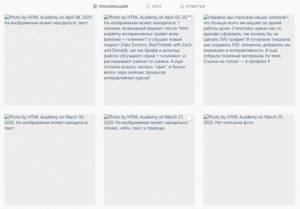
If you look now at the automatic generation of texts, there is always some assumption there - “ there may be 1 person in the image.”

With abstract pictures it’s even worse, since the AI doesn’t understand what’s going on at all.
Alt text is a drop in the ocean of the frontend
Everything else is in layout simulators. 11 introductory chapters for free, and −30% on subscription in the first week.
Registration
Clicking the button - consent to the processing of personal data
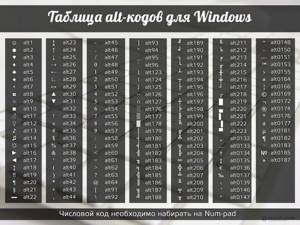
on Windows.
Sometimes it happens that we need to use some symbol, for example a degree, but looking at the keyboard we do not find the symbol we need. Some cms
have symbols and emoticons in the editor, but developers never use the full set of
symbols
.
Well, not all webmasters use ready-made website engines. Windows
still has
additional symbols
and there are a lot of them. I will now tell you how to use additional characters on the Windows keyboard.
If you are using a regular PC, then first we will turn on the NUM-pad panel, for those who do not know what it is - this is the right panel on the keyboard with numbers. Turn it on using the Num Lock button.
Then press the ALT
and the number of interest, for example 2. We managed to display a smiley ☻ And if we want to enter a character that consists of two or three numbers, then everything is just as simple, hold down alt and enter the desired number, for example - 197. Here is the result ┼ ALT is released only after the required combination has been entered. Symbols may differ slightly from those below due to fonts or be completely absent. Please like if the article helped!
Attention! Enter numbers only on the side Num-pad keyboard.
| Symbol | ALT Code | Symbol | ALT Code | Symbol | ALT Code | Symbol | ALT Code | Symbol | ALT Code |
| ☺ | Alt 1 | A | Alt 65 | ü | Alt 129 | ┼ | Alt 197 | ˆ | Alt 0136 |
| ☻ | Alt 2 | B | Alt 66 | é | Alt 130 | ╞ | Alt 198 | ‰ | Alt 0137 |
| ♥ | Alt 3 | C | Alt 67 | â | Alt 131 | ╟ | Alt 199 | Š | Alt 0138 |
| ♦ | Alt 4 | D | Alt 68 | ä | Alt 132 | ╚ | Alt 200 | ‹ | Alt 0139 |
| ♣ | Alt 5 | E | Alt 69 | a | Alt 133 | ╔ | Alt 201 | Œ | Alt 0140 |
| ♠ | Alt 6 | F | Alt 70 | å | Alt 134 | ╩ | Alt 202 | TO | Alt 0141 |
| • | Alt 7 | G | Alt 71 | ç | Alt 135 | ╦ | Alt 203 | Ž | Alt 0142 |
| ◘ | Alt 8 | H | Alt 72 | ê | Alt 136 | ╠ | Alt 204 | ‘ | Alt 0145 |
| ○ | Alt 9 | I | Alt 73 | ë | Alt 137 | ═ | Alt 205 | ’ | Alt 0146 |
| ◙ | Alt 10 | J | Alt 74 | è | Alt 138 | ╬ | Alt 206 | “ | Alt 0147 |
| ♂ | Alt 11 | K | Alt 75 | • | Alt 139 | ╧ | Alt 207 | ” | Alt 0148 |
| ♀ | Alt 12 | L | Alt 76 | o | Alt 140 | ╨ | Alt 208 | – | Alt 0150 |
| ♪ | Alt 13 | M | Alt 77 | - | Alt 141 | ╤ | Alt 209 | — | Alt 0151 |
| ♫ | Alt 14 | N | Alt 78 | æ | Alt 145 | ╥ | Alt 210 | Alt 0152 | |
| ☼ | Alt 15 | O | Alt 79 | Æ | Alt 146 | ╙ | Alt 211 | ™ | Alt 0153 |
| ► | Alt 16 | P | Alt 80 | o | Alt 147 | ╘ | Alt 212 | š | Alt 0154 |
| ◄ | Alt 17 | Q | Alt 81 | o | Alt 148 | ╒ | Alt 213 | › | Alt 0155 |
| ↕ | Alt 18 | R | Alt 82 | ò | Alt 149 | ╓ | Alt 214 | – | Alt 0156 |
| ‼ | Alt 19 | S | Alt 83 | û | Alt 150 | ╫ | Alt 215 | ž | Alt 0158 |
| ¶ | Alt 20 | T | Alt 84 | ù | Alt 151 | ╪ | Alt 216 | Ÿ | Alt 0159 |
| § | Alt 21 | U | Alt 85 | ÿ | Alt 152 | ┘ | Alt 217 | ¤ | Alt 0164 |
| ▬ | Alt 22 | V | Alt 86 | ¢ | Alt 155 | ┌ | Alt 218 | ¦ | Alt 0166 |
| ↨ | Alt 23 | W | Alt 87 | £ | Alt 156 | █ | Alt 219 | ¨ | Alt 0168 |
| ↑ | Alt 24 | X | Alt 88 | ¥ | Alt 157 | ▄ | Alt 220 | © | Alt 0169 |
| ↓ | Alt 25 | Y | Alt 89 | ₧ | Alt 158 | ▌ | Alt 221 | ® | Alt 0174 |
| → | Alt 26 | Z | Alt 90 | ƒ | Alt 159 | ▐ | Alt 222 | ¯ | Alt 0175 |
| ← | Alt 27 | [ | Alt 91 | b | Alt 160 | ▀ | Alt 223 | ³ | Alt 0179 |
| ∟ | Alt 28 | \ | Alt 92 | í | Alt 161 | α | Alt 224 | ´ | Alt 0180 |
| ↔ | Alt 29 | ] | Alt 93 | o | Alt 162 | ß | Alt 225 | ¸ | Alt 0184 |
| ▲ | Alt 30 | Alt 94 | ú | Alt 163 | Γ | Alt 226 | U | Alt 0185 | |
| ▼ | Alt 31 | _ | Alt 95 | ñ | Alt 164 | π | Alt 227 | ¾ | Alt 0190 |
| Alt 32 | ` | Alt 96 | С | Alt 165 | Σ | Alt 228 | À | Alt 0192 | |
| ! | Alt 33 | a | Alt 97 | ª | Alt 166 | σ | Alt 229 | Á | Alt 0193 |
| « | Alt 34 | b | Alt 98 | º | Alt 167 | µ | Alt 230 | Â | Alt 0194 |
| # | Alt 35 | c | Alt 99 | ¿ | Alt 168 | τ | Alt 231 | Ã | Alt 0195 |
| $ | Alt 36 | d | Alt 100 | ⌐ | Alt 169 | Φ | Alt 232 | Ä | Alt 0196 |
| % | Alt 37 | e | Alt 101 | ¬ | Alt 170 | Θ | Alt 233 | Å | Alt 0197 |
| & | Alt 38 | f | Alt 102 | ½ | Alt 171 | Ω | Alt 234 | È | Alt 0200 |
| ‘ | Alt 39 | g | Alt 103 | ¼ | Alt 172 | δ | Alt 235 | É | Alt 0201 |
| ( | Alt 40 | h | Alt 104 | ¡ | Alt 173 | ∞ | Alt 236 | Ê | Alt 0202 |
| ) | Alt 41 | i | Alt 105 | « | Alt 174 | φ | Alt 237 | Ë | Alt 0203 |
| * | Alt 42 | j | Alt 106 | » | Alt 175 | ε | Alt 238 | Ì | Alt 0204 |
| + | Alt 43 | k | Alt 107 | ░ | Alt 176 | ∩ | Alt 239 | Í | Alt 0205 |
| , | Alt 44 | l | Alt 108 | ▒ | Alt 177 | ≡ | Alt 240 | О | Alt 0206 |
| — | Alt 45 | m | Alt 109 | ▓ | Alt 178 | ± | Alt 241 | Ï | Alt 0207 |
| . | Alt 46 | n | Alt 110 | │ | Alt 179 | ≥ | Alt 242 | Ð | Alt 0208 |
| / | Alt 47 | o | Alt 111 | ┤ | Alt 180 | ≤ | Alt 243 | Т | Alt 0210 |
| 0 | Alt 48 | p | Alt 112 | ╡ | Alt 181 | ⌠ | Alt 244 | Ó | Alt 0211 |
| 1 | Alt 49 | q | Alt 113 | ╢ | Alt 182 | ⌡ | Alt 245 | Ô | Alt 0212 |
| 2 | Alt 50 | r | Alt 114 | ╖ | Alt 183 | ÷ | Alt 246 | Õ | Alt 0213 |
| 3 | Alt 51 | s | Alt 115 | ╕ | Alt 184 | ≈ | Alt 247 | Ö | Alt 0214 |
| 4 | Alt 52 | t | Alt 116 | ╣ | Alt 185 | ° | Alt 248 | × | Alt 0215 |
| 5 | Alt 53 | u | Alt 117 | ║ | Alt 186 | • | Alt 249 | Ø | Alt 0216 |
| 6 | Alt 54 | v | Alt 118 | ╗ | Alt 187 | · | Alt 250 | Ù | Alt 0217 |
| 7 | Alt 55 | w | Alt 119 | ╝ | Alt 188 | √ | Alt 251 | Ú | Alt 0218 |
| 8 | Alt 56 | x | Alt 120 | ╜ | Alt 189 | ⁿ | Alt 252 | Û | Alt 0219 |
| 9 | Alt 57 | y | Alt 121 | ╛ | Alt 190 | ² | Alt 253 | Ü | Alt 0220 |
| : | Alt 58 | z | Alt 122 | ┐ | Alt 191 | ■ | Alt 254 | Ý | Alt 0221 |
| ; | Alt 59 | { | Alt 123 | └ | Alt 192 | € | Alt 0128 | Þ | Alt 0222 |
| < | Alt 60 | | | Alt 124 | ┴ | Alt 193 | „ | Alt 0132 | ã | Alt 0227 |
| = | Alt 61 | } | Alt 125 | ┬ | Alt 194 | … | Alt 0133 | ð | Alt 0240 |
| > | Alt 62 | ~ | Alt 126 | ├ | Alt 195 | † | Alt 0134 | ý | Alt 0253 |
| ? | Alt 63 | ⌂ | Alt 127 | ─ | Alt 196 | ‡ | Alt 0135 | þ | Alt 0254 |
| @ | Alt 64 | Ç | Alt 128 |
The download link is available only to authorized users, please register. This will take no more than a minute. Don't worry, we don't spam!
